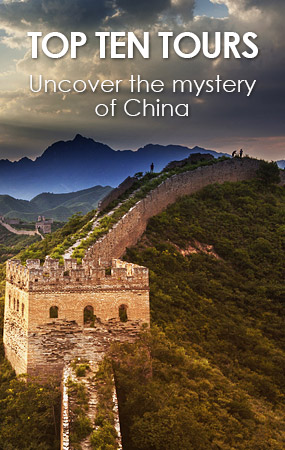Calligraphy
Calligraphy is understood in China as the art of writing a good hand with the brush or the study of the rules and techniques of this art. As such it is peculiar to China and the few countries influenced by ancient Chinese culture.
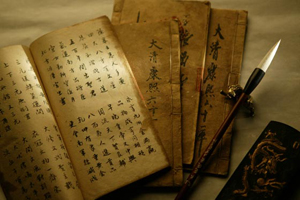 In the history of Chinese art, calligraphy has always been held in equal importance to painting. Great attention is also paid today to its development by holding exhibitions of ancient and contemporary works and by organizing competitions among youngsters and people from various walks of life. Sharing of experience in this field often makes a feature in Sino-Japanese cultural exchange.
In the history of Chinese art, calligraphy has always been held in equal importance to painting. Great attention is also paid today to its development by holding exhibitions of ancient and contemporary works and by organizing competitions among youngsters and people from various walks of life. Sharing of experience in this field often makes a feature in Sino-Japanese cultural exchange.
Chinese calligraphy, like the script itself, began with the hieroglyphs and, over the long ages of evolution, has developed various styles and schools, constituting an important part of the heritage of national culture.
Chinese scripts are generally divided into five categories:
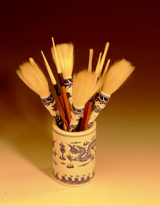 The seal character (zhuan), the official or clerical script (li), the regular script (kai), the running hand (xing) and the cursive hand (cao).
The seal character (zhuan), the official or clerical script (li), the regular script (kai), the running hand (xing) and the cursive hand (cao).
1) The zhuan script or seal character was the earliest form of writing after the oracle inscriptions, which must have caused great inconvenience because they lacked uniformity and many characters were written in variant forms. The first effort for the unification of writing, it is said, took place during the reign of King Xuan (827-782 B. C.) of the Western Zhou Dynasty, when his taishi (grand historian) Shi Zhou compiled a lexicon of 15 chapters, standardizing Chinese writing under script called zhuan. 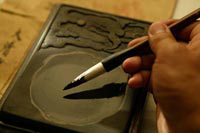 It is also known as zhouwen after the name of the author. This script, often used in seals, is translated into English as the seal character, or as the "curly script" after the shape of its strokes.
It is also known as zhouwen after the name of the author. This script, often used in seals, is translated into English as the seal character, or as the "curly script" after the shape of its strokes.
Shi Zhou's lexicon (which some thought was written by a later author of the state of Qin) had long been lost, yet it is generally agreed that the inscriptions on the drum-shaped Qin stone blocks were basically of the same style as the old zhuan script.
When, in 221 B. C., Emperor Qin Shi Huang unified the whole of China under one central government, he ordered his Prime Minister Li Si to collect and sort out all the different systems of writing hitherto prevalent in different parts of the country in a great effort to unify the written language under one system. What Li did, in effect, was to simplify the ancient zhuan (small seal) script.
Today we have a most valuable relic of this ancient writing in the creator Li Si's own hand engraved on a stele standing in the Temple to the God of Taishan Mountain in Shandong Province. The 2,200-year-old stele, worn by age and weather, has only nine and a half characters left on it.
2) The lishu (official script) came in the wake of the xiaozhuan in the same short-lived Qin Dynasty (221 - 207 B. C.). This was because the xiaozhuan, though a simplified form of script, was still too complicated for the scribes in the various government offices who had to copy an increasing amount of documents. 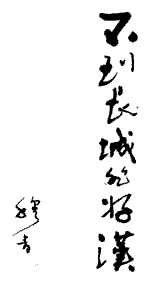 Cheng Miao, a prison warden, made a further simplification of the xiaozhuan, changing the curly strokes into straight and angular ones and thus making writing much easier. A further step away from the pictographs, it was named lishu because li in classical Chinese meant "clerk" or "scribe". Another version says that Cheng Miao, because of certain offence, became a prisoner and slave himself; as the ancients also called bound slaves "li", so the script was named lishu or the "script of a slave".
Cheng Miao, a prison warden, made a further simplification of the xiaozhuan, changing the curly strokes into straight and angular ones and thus making writing much easier. A further step away from the pictographs, it was named lishu because li in classical Chinese meant "clerk" or "scribe". Another version says that Cheng Miao, because of certain offence, became a prisoner and slave himself; as the ancients also called bound slaves "li", so the script was named lishu or the "script of a slave".
3) The lishu was already very close to, and led to the adoption of, kaishu, regular script. The oldest existing example of this dates from the Wei (220-265), and the script developed under the Jin (265-420). The standard writing today is square in form, non-cursive and architectural in style. The characters are composed of a number of strokes out of a total of eight kinds-the dot, the horizontal, the vertical, the hook, the rising, the left-falling (short and long) and the right-falling strokes. Any aspirant for the status of calligrapher must start by learning to write a good hand in kaishu.
4) On the basis of lishu also evolved caoshu (grass writing or cursive hand), which is rapid and used for making quick but rough copies. This style is subdivided into two schools: zhangcao and jincao.
The first of these emerged at the time the Qin was replaced by the Han Dynasty between the 3rd and 2nd centuries B. C. The characters, though written rapidly, still stand separate one from another and the dots are not linked up with other strokes.
Jincao or the modern cursive hand is said to have been developed by Zhang Zhi (?-c. 192 A. D.) of the Eastern Han Dynasty, flourished in the Jin and Tang dynasties and is still widely popular today.
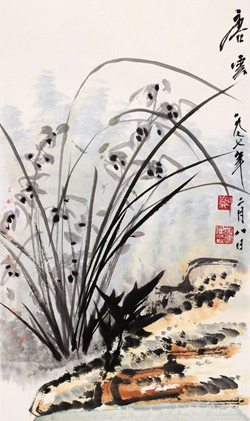 It is the essence of the caoshu, especially jincao, that the characters are executed swiftly with the strokes running together. The characters are often joined up, with the last stroke of the first merging into the initial stroke of the next. They also vary in size in the same piece of writing, all seemingly dictated by the whims of the writer.
It is the essence of the caoshu, especially jincao, that the characters are executed swiftly with the strokes running together. The characters are often joined up, with the last stroke of the first merging into the initial stroke of the next. They also vary in size in the same piece of writing, all seemingly dictated by the whims of the writer.
A great master at caoshu was Zhang Xu (early 8th century) of the Tang Dynasty, noted for the complete abandon with which he applied the brush. It is said that he would not set about writing until he had got drunk. This he did, allowing the brush to "gallop" across the paper, curling, twisting or meandering in one unbroken stroke, thus creating an original style. Today one may still see fragments of a stele carved with characters in his handwriting, kept in the Provincial Museum of Shaanxi.
The best example and model for xingshu, all Chinese calligraphers will agree, is the Inscription on Lanting Pavilion in the hand of Wang Xizhi (321-379) of the Eastern Jin Dynasty. To learn to write a nice hand in Chinese calligraphy, assiduous and persevering practice is necessary. This has been borne out by the many great masters China has produced. Wang Xizhi, the great artist just mentioned, who has exerted a profound influence on, and has been held in high esteem by, calligraphers and scholars throughout history, is said to have blackened in his childhood all the water of a pond in front of his house by washing the writing implements in it after his daily exercises. Another master, Monk Zhiyong of the Sui Dynasty (581-618) was so industrious in learning calligraphy that he filled many jars with worn-out writing brushes, which he buried in a "tomb of brushes".
Renewed interest in brush-writing has been kindled today among the pupils in China, some of whom already show promises as worthy successors to the ancient masters.

